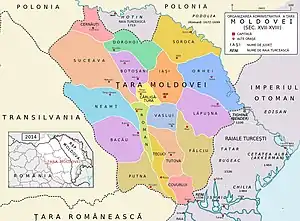Administrative divisions of Moldavia
A ținut (pl. ținuturi; sometimes translated in English as "region",[1] "district"[2] or "municipality"[3]) were the traditional subdivision of the Principality of Moldavia (1359–1859).
Principality of Moldavia (late 14th century – 1859)
-en.png.webp)
Ținuturi in the Principality of Moldavia in 1483

Ținuturi of Moldavia (17th-18th centuries), according to Dimitrie Cantemir's Descriptio Moldaviae
Lower Country (Țara de Jos)
|
|
|
Upper Country (Țara de Sus)
|
|
Historic Bessarabia (Basarabia)
|
Southern Bessarabia (Sudul Basarabiei)
See also
References
- Constantin C. Giurescu, The making of the Romanian unitary state, Editura Meridiane, 1971. p. 45.
- Pompiliu Teodor, Enlightenment and Romanian society, Editura Dacia, 1980. p. 74
- Gerald J. Bobang, The emergence of the Romanian national State, East European Quarterly, 1979. ISBN 0-914710-51-6. p. 227.
Further reading
- Dimitrie Cantemir, "Descriptio Molaviae", 1737
- Ion Nistor, "Istoria Basarabiei", 1923, reprinted 1991
- Portretul Romaniei interbelice
This article is issued from Wikipedia. The text is licensed under Creative Commons - Attribution - Sharealike. Additional terms may apply for the media files.